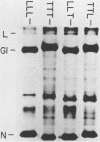Abstract
To identify which RNA segments of the California serogroup bunyaviruses determine virulence, we prepared reassortant viruses by coinfecting BHK-21 cells with two wild-type parents, La Crosse/original and Tahyna/181-57 viruses, which differed about 30,000-fold in virulence. The progeny clones were screened by polyacrylamide gel electrophoresis to ascertain the phenotype of the M and S RNA segments, and RNA-RNA hybridization was used to determine the genotype of selected clones. Two or three clones of each of the six possible reassortant genotypes were characterized quantitatively for neuroinvasiveness by determining the PFU/50% lethal dose (LD50) ratio after subcutaneous injection into suckling mice. The reassortants fell into two groups. (i) Six of seven reassortants with a La Crosse M RNA segment were as virulent as the parent La Crosse virus (about 1 PFU/LD50); the one exception was strikingly different (about 1,000 PFU/LD50) and probably represents a spontaneous mutant. (ii) The seven reassortants with a Tahyna M RNA segment were about 10-fold more virulent than the parent Tahyna virus (median 1,600 PFU/LD50 for reassortants and 16,000 PFU/LD50 for Tahyna virus). A comparative pathogenesis study in suckling mice of one reassortant virus and the parent Tahyna virus confirmed the greater neuroinvasiveness of the reassortant virus. From these data it was concluded that the M RNA segment was the major determinant of virulence, but that the other two gene segments could modulate the virulence of a nonneuroinvasive California serogroup virus.
Full text
PDF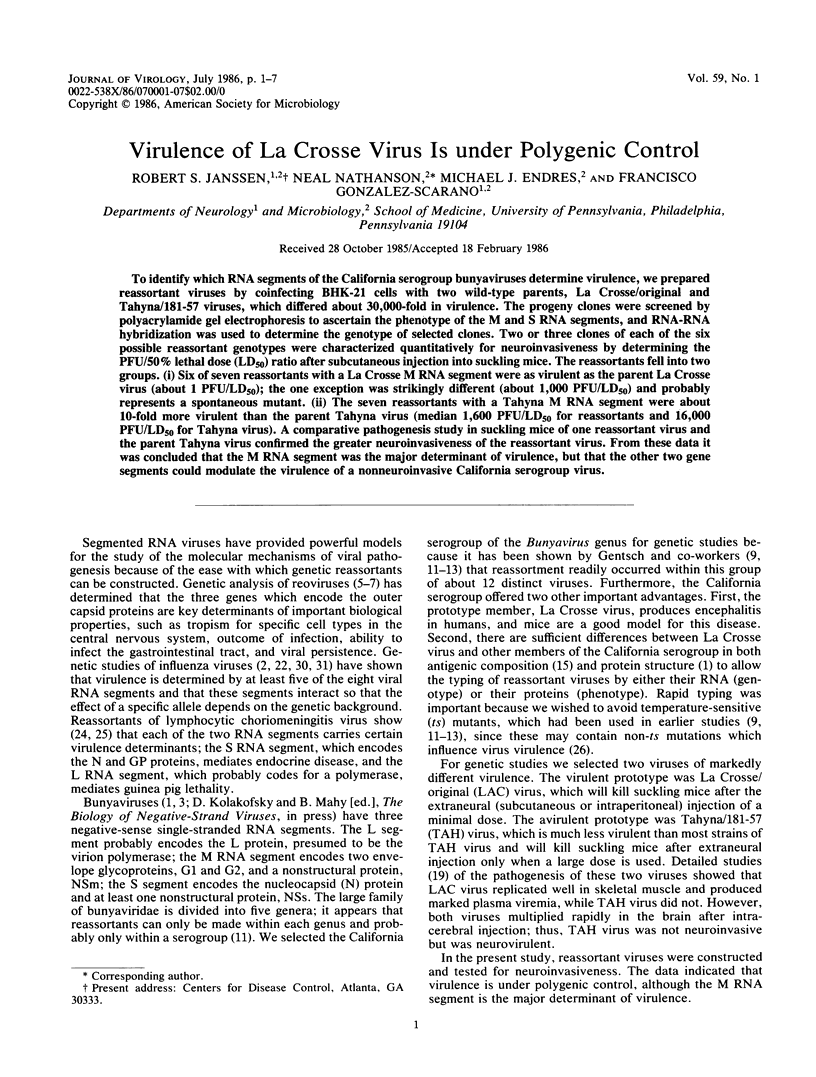
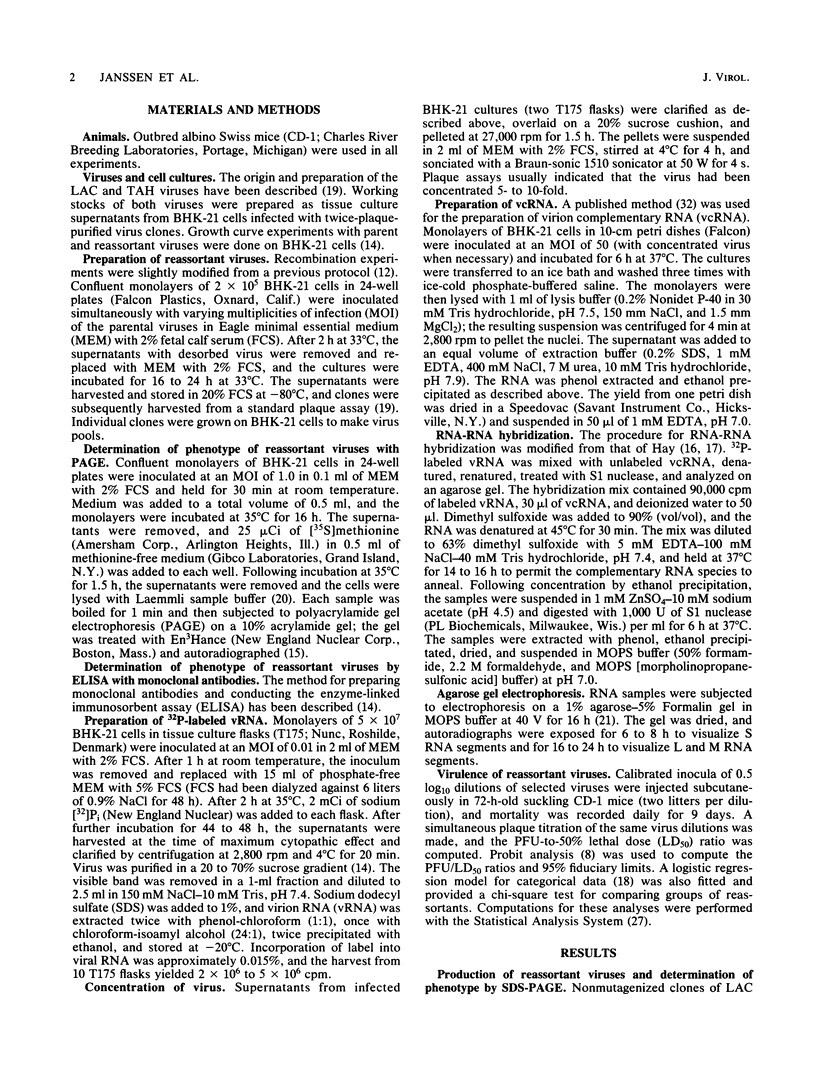
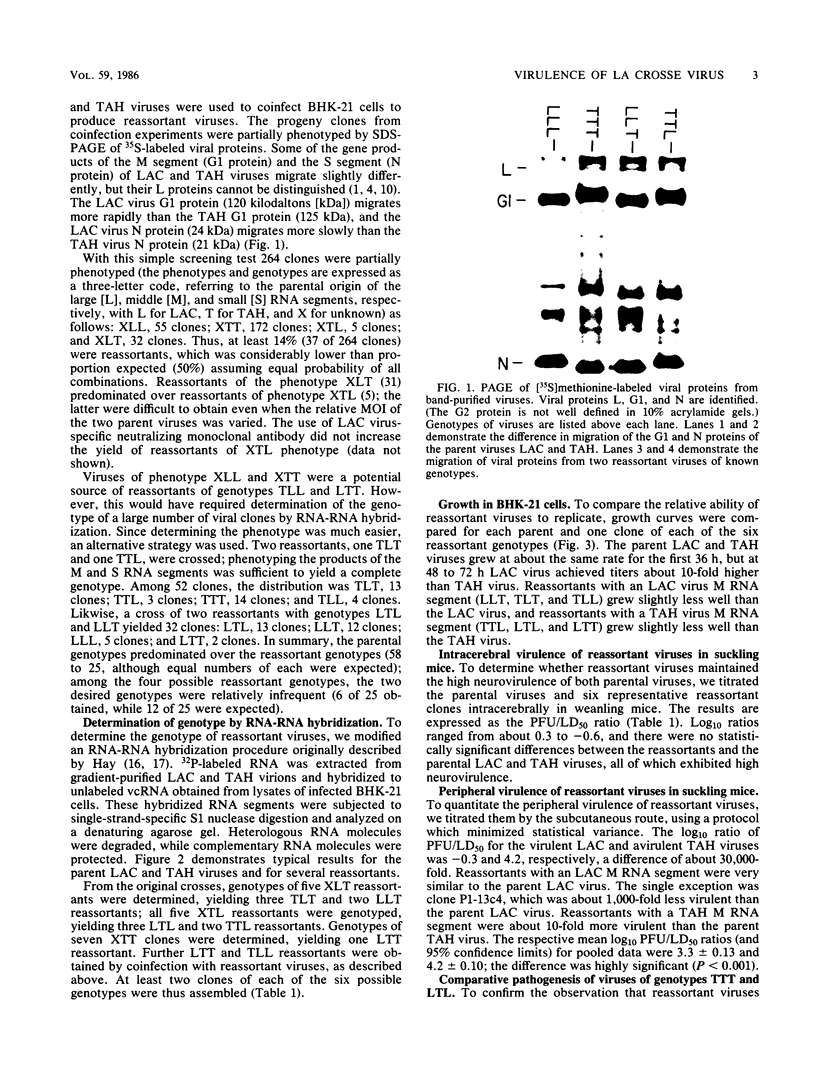
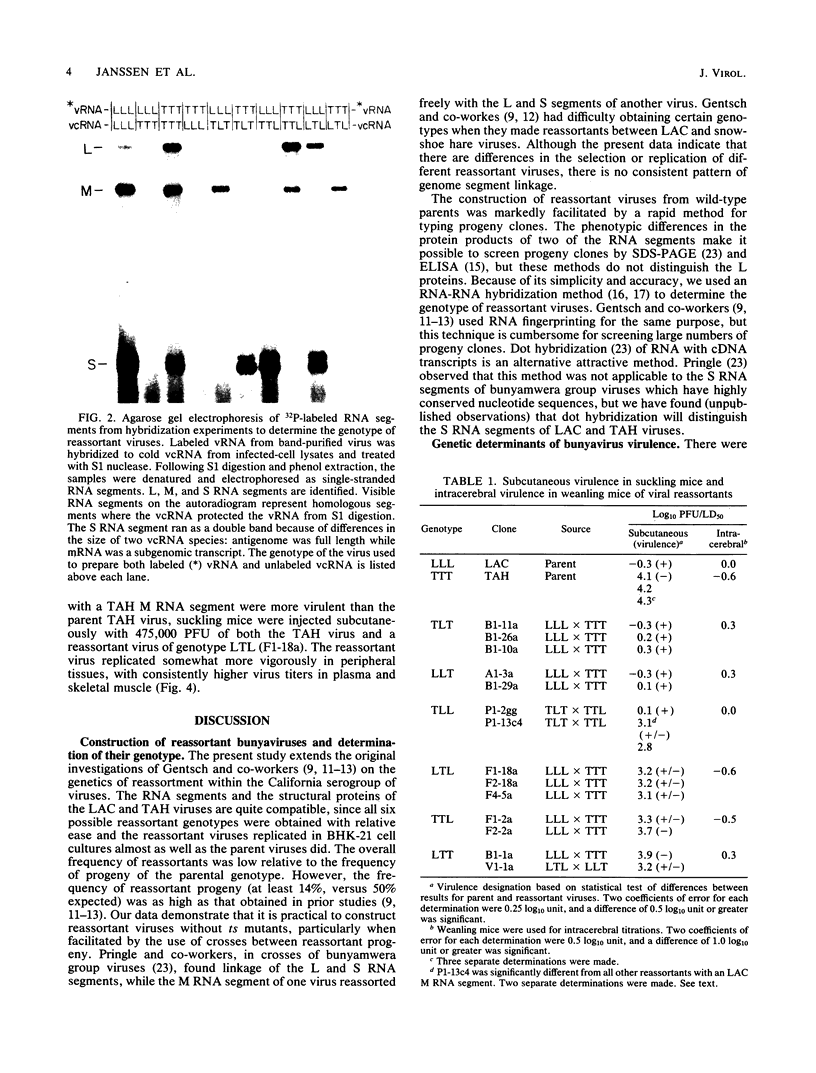
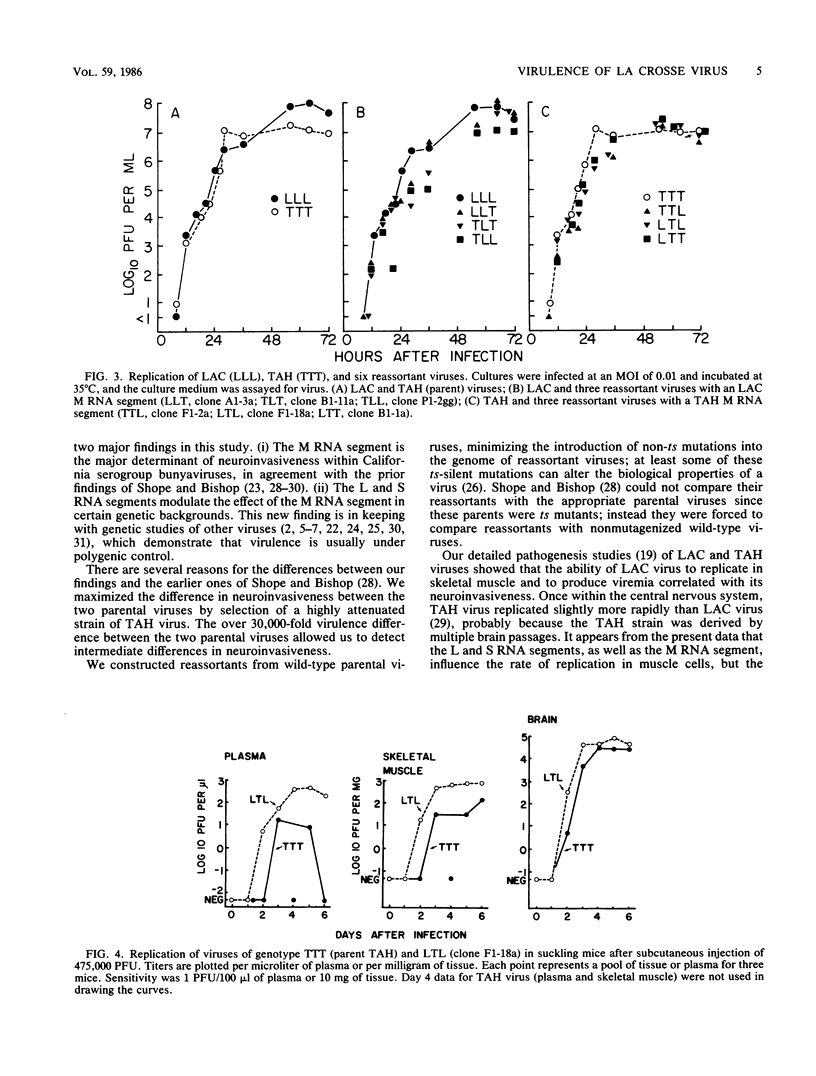
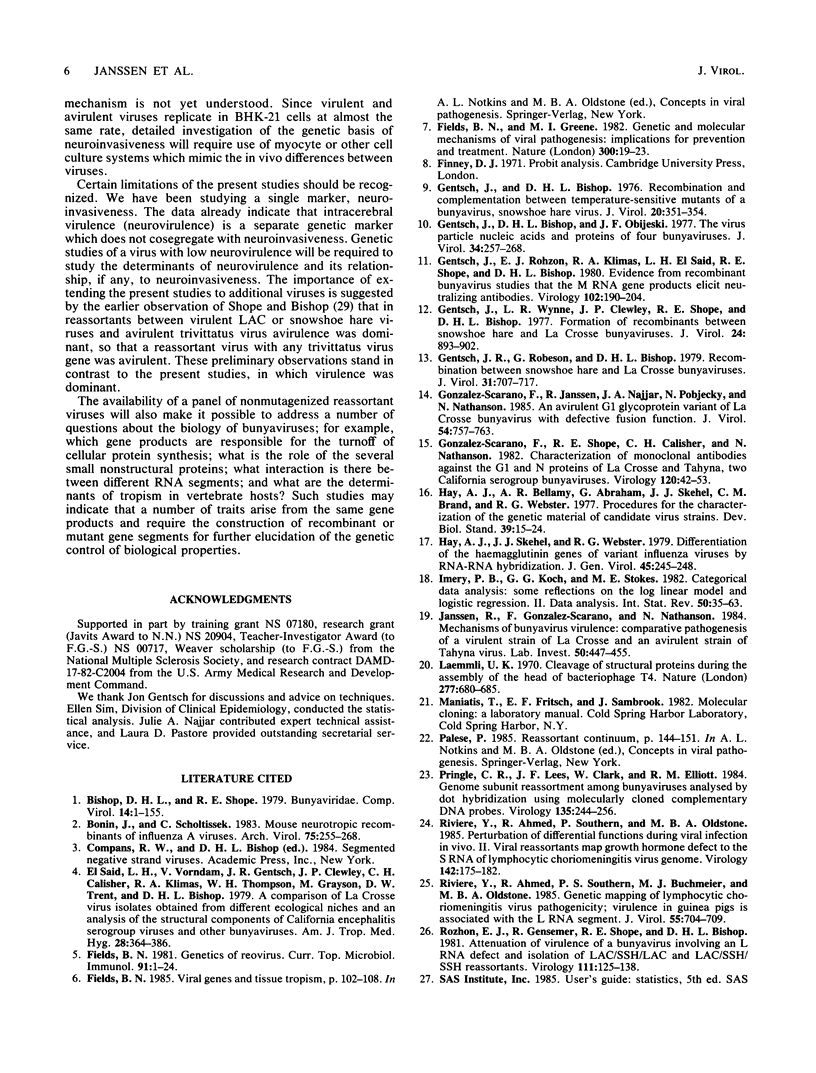
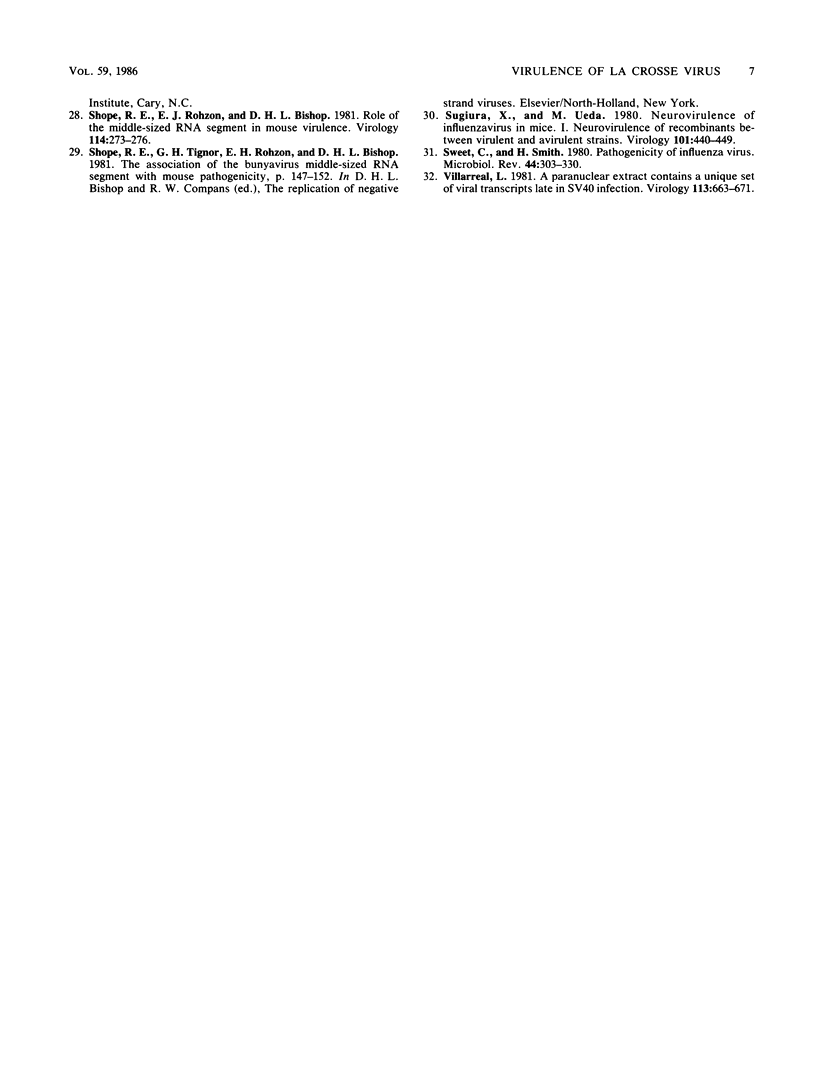
Images in this article
Selected References
These references are in PubMed. This may not be the complete list of references from this article.
- Bonin J., Scholtissek C. Mouse neurotropic recombinants of influenza A viruses. Arch Virol. 1983;75(4):255–268. doi: 10.1007/BF01314891. [DOI] [PubMed] [Google Scholar]
- El Said L. H., Vorndam V., Gentsch J. R., Clewley J. P., Calisher C. H., Klimas R. A., Thompson W. H., Grayson M., Trent D. W., Bishop D. H. A comparison of La Crosse virus isolated obtained from different ecological niches and an analysis of the structural components of California encephalitis serogroup viruses and other bunyaviruses. Am J Trop Med Hyg. 1979 Mar;28(2):364–386. doi: 10.4269/ajtmh.1979.28.364. [DOI] [PubMed] [Google Scholar]
- Fields B. N. Genetics of Reovirus. Curr Top Microbiol Immunol. 1981;91:1–24. doi: 10.1007/978-3-642-68058-8_1. [DOI] [PubMed] [Google Scholar]
- Fields B. N., Greene M. I. Genetic and molecular mechanisms of viral pathogenesis: implications for prevention and treatment. Nature. 1982 Nov 4;300(5887):19–23. doi: 10.1038/300019a0. [DOI] [PubMed] [Google Scholar]
- Gentsch J. R., Robeson G., Bishop D. H. Recombination between snowhoe hare and La Crosse bunyaviruses. J Virol. 1979 Sep;31(3):707–717. doi: 10.1128/jvi.31.3.707-717.1979. [DOI] [PMC free article] [PubMed] [Google Scholar]
- Gentsch J. R., Rozhon E. J., Klimas R. A., El Said L. H., Shope R. E., Bishop D. H. Evidence from recombinant bunyavirus studies that the M RNA gene products elicit neutralizing antibodies. Virology. 1980 Apr 15;102(1):190–204. doi: 10.1016/0042-6822(80)90080-x. [DOI] [PubMed] [Google Scholar]
- Gentsch J., Bishop D. H., Obijeski J. F. The virus particle nucleic acids and proteins of four bunyaviruses. J Gen Virol. 1977 Feb;34(2):257–268. doi: 10.1099/0022-1317-34-2-257. [DOI] [PubMed] [Google Scholar]
- Gentsch J., Bishop D. H. Recombination and complementation between temperature-sensitive mutants of a Bunyavirus, snowshoe hare virus. J Virol. 1976 Oct;20(1):351–354. doi: 10.1128/jvi.20.1.351-354.1976. [DOI] [PMC free article] [PubMed] [Google Scholar]
- Gentsch J., Wynne L. R., Clewley J. P., Shope R. E., Bishop D. H. Formation of recombinants between snowshoe hare and La Crosse bunyaviruses. J Virol. 1977 Dec;24(3):893–902. doi: 10.1128/jvi.24.3.893-902.1977. [DOI] [PMC free article] [PubMed] [Google Scholar]
- Gonzalez-Scarano F., Janssen R. S., Najjar J. A., Pobjecky N., Nathanson N. An avirulent G1 glycoprotein variant of La Crosse bunyavirus with defective fusion function. J Virol. 1985 Jun;54(3):757–763. doi: 10.1128/jvi.54.3.757-763.1985. [DOI] [PMC free article] [PubMed] [Google Scholar]
- Gonzalez-Scarano F., Shope R. E., Calisher C. E., Nathanson N. Characterization of monoclonal antibodies against the G1 and N proteins of LaCrosse and Tahyna, two California serogroup bunyaviruses. Virology. 1982 Jul 15;120(1):42–53. doi: 10.1016/0042-6822(82)90005-8. [DOI] [PubMed] [Google Scholar]
- Hay A. J., Bellamy A. R., Abraham G., Skehel J. J., Brand C. M., Webster R. G. Procedures for characterisation of the genetic material of candidate vaccine strains. Dev Biol Stand. 1977 Jun 1;39:15–24. [PubMed] [Google Scholar]
- Hay A. J., Skehel J. J., Webster R. G. Differentiation of the haemagglutinin genes of variant influenza viruses by RNA-RNA hybridization. J Gen Virol. 1979 Oct;45(1):245–248. doi: 10.1099/0022-1317-45-1-245. [DOI] [PubMed] [Google Scholar]
- Janssen R., Gonzalez-Scarano F., Nathanson N. Mechanisms of bunyavirus virulence. Comparative pathogenesis of a virulent strain of La Crosse and an avirulent strain of Tahyna virus. Lab Invest. 1984 Apr;50(4):447–455. [PubMed] [Google Scholar]
- Laemmli U. K. Cleavage of structural proteins during the assembly of the head of bacteriophage T4. Nature. 1970 Aug 15;227(5259):680–685. doi: 10.1038/227680a0. [DOI] [PubMed] [Google Scholar]
- Pringle C. R., Lees J. F., Clark W., Elliott R. M. Genome subunit reassortment among Bunyaviruses analysed by dot hybridization using molecularly cloned complementary DNA probes. Virology. 1984 May;135(1):244–256. doi: 10.1016/0042-6822(84)90134-x. [DOI] [PubMed] [Google Scholar]
- Riviere Y., Ahmed R., Southern P. J., Buchmeier M. J., Oldstone M. B. Genetic mapping of lymphocytic choriomeningitis virus pathogenicity: virulence in guinea pigs is associated with the L RNA segment. J Virol. 1985 Sep;55(3):704–709. doi: 10.1128/jvi.55.3.704-709.1985. [DOI] [PMC free article] [PubMed] [Google Scholar]
- Riviere Y., Ahmed R., Southern P., Oldstone M. B. Perturbation of differentiated functions during viral infection in vivo. II. Viral reassortants map growth hormone defect to the S RNA of the lymphocytic choriomeningitis virus genome. Virology. 1985 Apr 15;142(1):175–182. doi: 10.1016/0042-6822(85)90431-3. [DOI] [PubMed] [Google Scholar]
- Rozhon E. J., Gensemer P., Shope R. E., Bishop D. H. Attenuation of virulence of a bunyavirus involving an L RNA defect and isolation of LAC/SSH/LAC and LAC/SSH/SSH reassortants. Virology. 1981 May;111(1):125–138. doi: 10.1016/0042-6822(81)90659-0. [DOI] [PubMed] [Google Scholar]
- Shope R. E., Rozhon E. J., Bishop D. H. Role of the middle-sized bunyavirus RNA segment in mouse virulence. Virology. 1981 Oct 15;114(1):273–276. doi: 10.1016/0042-6822(81)90276-2. [DOI] [PubMed] [Google Scholar]
- Sugiura A., Ueda M. Neurovirulence of influenza virus in mice. I. Neurovirulence of recombinants between virulent and avirulent virus strains. Virology. 1980 Mar;101(2):440–449. doi: 10.1016/0042-6822(80)90457-2. [DOI] [PubMed] [Google Scholar]
- Sweet C., Smith H. Pathogenicity of influenza virus. Microbiol Rev. 1980 Jun;44(2):303–330. doi: 10.1128/mr.44.2.303-330.1980. [DOI] [PMC free article] [PubMed] [Google Scholar]
- Villarreal L. A paranuclear extract contains a unique set of viral transcripts late in SV40 infection. Virology. 1981 Sep;113(2):663–671. doi: 10.1016/0042-6822(81)90195-1. [DOI] [PubMed] [Google Scholar]



